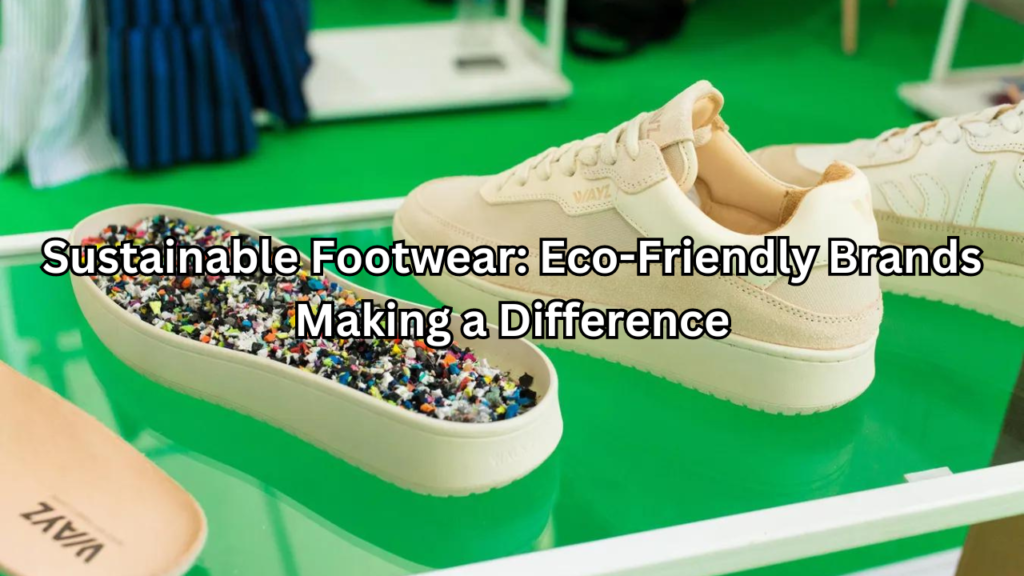

Table of Contents
Introduction
In an era where environmental concerns are at the forefront of global conversations, the fashion industry faces increasing pressure to adopt more sustainable practices. Footwear, a ubiquitous aspect of our daily lives, is no exception. With the rise of eco-conscious consumers, sustainable footwear is emerging as a key player in the movement toward a greener future. This article delves into what sustainable footwear truly means, why making eco-friendly choices is crucial in the fashion industry, and the significant environmental impact of traditional footwear manufacturing.
Definition of Sustainable Footwear
Sustainable footwear refers to shoes designed with the environment in mind, emphasizing eco-friendly practices throughout their lifecycle. This includes the use of materials that are renewable, recyclable, or biodegradable, and the adoption of manufacturing processes that minimize waste and reduce carbon footprints. Sustainable footwear often incorporates innovative designs and technologies that not only extend the life of the product but also ensure that its environmental impact is as low as possible. Key elements include the use of organic or recycled materials, low-impact dyes, and ethical labor practices.
Importance of Eco-Friendly Choices in the Fashion Industry
The fashion industry is one of the largest contributors to environmental degradation, with conventional footwear production being a significant culprit. By choosing eco-friendly options, consumers can drive demand for more sustainable practices and products. This shift is crucial for several reasons:
Reduction in Resource Consumption: Sustainable footwear often uses materials that are less resource-intensive, helping to conserve natural resources and reduce the industry’s overall environmental footprint.
Waste Minimization: Eco-friendly practices, such as recycling and upcycling, help reduce waste generated during manufacturing and at the end of the product’s life.
Lower Carbon Emissions: Brands committed to sustainability often implement energy-efficient production methods and use renewable energy sources, contributing to a reduction in greenhouse gas emissions.
Ethical Considerations: Sustainable footwear brands frequently prioritize fair labor practices and ethical treatment of workers, aligning consumer choices with broader social responsibility goals.
Overview of the Impact of Conventional Footwear on the Environment
Traditional footwear manufacturing has a profound impact on the environment, encompassing various stages from production to disposal:
Material Sourcing: Conventional footwear often relies on non-renewable materials, such as synthetic plastics and leather tanned with toxic chemicals. These materials contribute to resource depletion and environmental pollution.
Production Processes: The manufacturing process for traditional footwear can be highly polluting, involving the release of hazardous chemicals and generating substantial waste. Energy-intensive processes also contribute to high carbon emissions.
Waste and Disposal: Footwear typically has a short lifespan, and once discarded, many conventional shoes end up in landfills. Since synthetic materials can take hundreds of years to decompose, this creates a significant waste management challenge.
Environmental Pollution: The production and disposal of conventional footwear contribute to air and water pollution, further exacerbating environmental issues and harming ecosystems.
By understanding these impacts and the benefits of sustainable alternatives, consumers and manufacturers alike can make more informed choices that support environmental stewardship and promote a more sustainable future for footwear.
The Rise of Sustainable Footwear
Historical Context: How and Why the Movement Began
The movement towards sustainable footwear can be traced back to broader environmental and ethical concerns that gained momentum in the late 20th and early 21st centuries. Initially, the focus on sustainability was primarily driven by the growing awareness of environmental degradation and the need for more responsible manufacturing practices across various industries. The footwear sector, traditionally known for its resource-intensive and polluting processes, began to face scrutiny as part of this larger conversation.
In the early 2000s, the rise of environmental activism and increased media coverage of climate change and pollution highlighted the urgent need for change. Brands and consumers alike started questioning the environmental and social impact of conventional products. This led to the emergence of sustainable footwear as a niche market, driven by innovators and pioneers who sought to address the industry’s substantial ecological footprint.
Key Drivers Behind the Trend
Consumer Demand: As awareness of environmental issues grew, consumers increasingly sought products that aligned with their values. The demand for transparency and eco-friendly options became a significant driver of the sustainable footwear trend. Shoppers wanted to support brands that were committed to reducing their environmental impact and adopting ethical practices.
Environmental Awareness: Growing concerns about climate change, pollution, and resource depletion spurred interest in sustainable products. The footwear industry, with its considerable environmental footprint, became a focal point for those advocating for greener alternatives. This awareness prompted both consumers and companies to seek out and support more sustainable practices.
Regulatory Pressure: Governments and international organizations began implementing stricter environmental regulations and standards. Brands faced increasing pressure to comply with these regulations, leading many to adopt sustainable practices as a way to avoid penalties and enhance their market position.
Technological Advancements: Innovations in materials and production techniques enabled the development of more sustainable footwear options. Advances such as biodegradable materials, recycled components, and energy-efficient manufacturing processes made it feasible for brands to offer eco-friendly products at scale.
Major Milestones in Sustainable Footwear Development
Early Adopters and Innovators (2000s): The early 2000s saw the emergence of pioneering brands like Patagonia and Timberland, which began incorporating sustainable practices into their footwear lines. These brands laid the groundwork for the movement by demonstrating that eco-friendly products could be both functional and stylish.
The Rise of Recycled Materials (2010s): The 2010s marked a significant shift with the introduction of footwear made from recycled materials. Brands like Adidas and their Parley for the Oceans collaboration began producing shoes made from ocean plastic waste, highlighting the potential for upcycling and recycling in the footwear industry.
Certification and Transparency (2015 and Beyond): The establishment of various certifications and standards, such as B Corp certification and the Global Organic Textile Standard (GOTS), provided a framework for assessing the sustainability of footwear. Brands increasingly sought these certifications to prove their commitment to environmental and social responsibility.
Innovative Designs and Materials (Late 2010s – Present): Recent years have seen the development of cutting-edge materials like bio-leathers and plant-based alternatives. Brands such as Allbirds and Veja have become prominent examples of how innovative designs and sustainable materials can combine to create high-performance, eco-friendly footwear.
Circular Economy Initiatives (2020s): The concept of circularity has gained traction, with brands focusing on creating products designed for longevity and recyclability. Initiatives such as Rothy’s recycling program and Nike’s Move to Zero campaign exemplify the industry’s commitment to reducing waste and closing the loop on product life cycles.
These milestones reflect a growing commitment to sustainability within the footwear industry, driven by both consumer demand and a collective recognition of the need for more responsible practices. As the movement continues to evolve, it is likely to spur further innovations and shape the future of footwear production and consumption.
Materials and Production Techniques
Overview of Sustainable Materials
Recycled Materials: One of the most significant advancements in sustainable footwear is the use of recycled materials. Brands are increasingly using recycled plastics, which can be sourced from ocean waste or post-consumer bottles. These materials reduce the need for virgin resources and help mitigate plastic pollution. For instance, Adidas’s Parley collection features shoes made from recycled ocean plastics, demonstrating a commitment to both innovation and environmental stewardship.
Organic Cotton: Organic cotton is grown without synthetic pesticides or fertilizers, which reduces soil and water contamination. This material is not only gentler on the environment but also often features in shoes for its breathability and comfort. Brands like Toms and Veja use organic cotton in their footwear lines to ensure a lower environmental footprint.
Bamboo: Bamboo is a fast-growing, renewable resource that requires minimal water and pesticides. Its natural antibacterial properties make it a popular choice for linings and insoles. Bamboo fibers are used in various footwear components, offering durability and comfort while maintaining sustainability.
Plant-Based Leathers: Alternatives to traditional leather, such as mushroom leather (mycelium), pineapple leather (Piñatex), and apple leather, are gaining traction. These materials are derived from plant sources and often have a lower environmental impact compared to conventional leather, which involves energy-intensive tanning processes.
Innovative Production Techniques
Low-Impact Dyes: Traditional dyeing processes can be highly polluting, using large amounts of water and toxic chemicals. Sustainable brands are adopting low-impact dyes made from natural or less harmful substances. These dyes reduce the environmental impact of the footwear and often result in a more vibrant and unique finish.
Water-Saving Processes: Water usage in conventional footwear manufacturing can be extensive, particularly in dyeing and finishing processes. Innovative techniques such as waterless dyeing and closed-loop water systems are being implemented to conserve water and reduce wastewater. For example, some brands use dry dyeing methods that eliminate the need for water altogether.
Energy-Efficient Manufacturing: Brands are increasingly focusing on energy-efficient production methods, including the use of renewable energy sources and energy-efficient machinery. This shift not only reduces carbon emissions but also contributes to a more sustainable production process overall.
3D Printing: 3D printing technology allows for precise manufacturing with minimal waste. It enables the creation of custom-fit footwear and reduces the need for large-scale production runs, which can help lower the environmental impact of the manufacturing process.
Comparison with Traditional Footwear Materials and Methods
Traditional footwear often relies on synthetic materials like polyurethane and PVC, which are derived from non-renewable resources and can take hundreds of years to decompose. The production processes for these materials are also energy-intensive and involve harmful chemicals. Conventional dyeing and finishing methods further contribute to water pollution and waste.
In contrast, sustainable materials and techniques aim to minimize environmental impact by using renewable resources, reducing waste, and lowering emissions. For instance, while traditional leather production involves toxic chemicals and significant water usage, plant-based leathers and low-impact dyes offer more eco-friendly alternatives. Additionally, the shift towards energy-efficient manufacturing and recycling methods represents a significant improvement over traditional practices.
Consumer Benefits of Choosing Sustainable Footwear
Personal Health Benefits: Sustainable footwear often utilizes non-toxic materials, which can be gentler on the skin and reduce exposure to harmful chemicals. Many conventional footwear products contain synthetic chemicals and adhesives that can cause irritation or allergic reactions. By choosing sustainable options, consumers can avoid these potential health issues and enjoy footwear that is safer for their well-being.
Long-Term Cost Savings: While sustainable footwear may have a higher upfront cost, it often provides long-term savings. High-quality materials and construction can lead to greater durability and longer wear, reducing the frequency of replacements. Additionally, the focus on timeless designs and versatile styles means that sustainable footwear can be a more cost-effective investment over time.
Enhanced Style and Innovation: Sustainable footwear is not just about function; it also offers style and innovation. Brands committed to sustainability are often at the forefront of design and technology, producing footwear that is both fashionable and environmentally responsible. Consumers can enjoy cutting-edge styles and innovative features while supporting brands that prioritize eco-friendly practices.
Choosing sustainable footwear offers numerous benefits, from improved personal health to long-term cost savings and access to innovative designs. By supporting eco-friendly brands, consumers contribute to a more sustainable future while enjoying high-quality and stylish footwear.
Challenges Facing the Sustainable Footwear Industry
Cost of Sustainable Materials and Production
One of the primary challenges in the sustainable footwear industry is the higher cost associated with eco-friendly materials and production processes. Sustainable materials, such as recycled plastics, organic cotton, and plant-based leathers, often come with a premium price tag due to their limited availability and the costs involved in sourcing and processing them. Additionally, innovative production techniques that reduce environmental impact, like low-impact dyes and water-saving methods, can also increase manufacturing costs. These higher costs are frequently passed on to consumers, which can limit the accessibility of sustainable footwear to a broader audience.
Limited Availability and Scalability
The availability of sustainable materials and the ability to scale production are significant hurdles. Many eco-friendly materials are still produced on a relatively small scale, which can limit their availability and make them more expensive. Furthermore, scaling up sustainable production processes to meet growing consumer demand requires substantial investment in technology and infrastructure. As the industry grows, overcoming these limitations is essential to ensure that sustainable footwear can become more widely available and affordable.
Greenwashing and Ensuring Genuine Sustainability
Greenwashing, where brands falsely or misleadingly claim to be environmentally friendly, is a major concern in the sustainable footwear industry. Some companies use eco-friendly buzzwords or superficial measures to appear sustainable without making substantial changes to their practices. This makes it challenging for consumers to distinguish between genuinely sustainable brands and those merely capitalizing on the trend. Ensuring transparency and verifying the authenticity of sustainability claims are critical for maintaining consumer trust and promoting genuine eco-friendly practices.
How to Support and Choose Sustainable Footwear
Tips for Identifying Truly Sustainable Brands
Look for Certifications: Seek out brands that have received third-party certifications, such as B Corp, Global Organic Textile Standard (GOTS), or Fair Trade. These certifications indicate that the brand meets rigorous environmental and social criteria.
Check Material Sources: Investigate the materials used in the women footwear. Brands that prioritize recycled, organic, or plant-based materials are generally more sustainable.
Review Brand Transparency: Choose brands that openly share information about their supply chain, manufacturing processes, and environmental impact. Transparency is a key indicator of a brand’s commitment to sustainability.
Research Brand Values: Look for brands that actively engage in sustainability initiatives, such as carbon offset programs, waste reduction efforts, and ethical labor practices.
How to Evaluate the Sustainability of a Product
Assess Material Composition: Examine the materials used in the product. Sustainable footwear often features recycled, organic, or biodegradable components. Avoid products with synthetic or non-renewable materials.
Evaluate Production Practices: Investigate the manufacturing processes. Sustainable products are typically produced using energy-efficient methods, low-impact dyes, and water-saving techniques.
Consider the Product’s Lifecycle: Look for footwear designed for durability and repairability. Products that can be easily repaired or recycled at the end of their life are more sustainable.
Check for Third-Party Verification: Verify the product’s sustainability claims through independent certifications or audits.
Suggestions for Integrating Sustainable Footwear into Your Wardrobe
Prioritize Quality Over Quantity: Invest in high-quality, durable footwear that will last longer, reducing the need for frequent replacements.
Mix and Match: Incorporate sustainable footwear into your existing wardrobe by choosing versatile styles that complement various outfits.
Support Brands with Recycling Programs: Look for brands that offer take-back or recycling programs for old footwear, helping to close the loop on product lifecycle.
Educate Yourself and Others: Stay informed about sustainable practices and share your knowledge with friends and family to encourage broader adoption of eco-friendly choices.
Future Trends in Sustainable Footwear
Emerging Technologies and Innovations
Biodegradable Materials: The development of fully biodegradable materials, such as mycelium-based leathers and plant-based alternatives, is expected to revolutionize sustainable footwear. These materials decompose more naturally, reducing landfill waste.
3D Printing and Customization: Advances in 3D printing technology allow for custom-fit footwear with minimal waste. This technology can also enable on-demand production, reducing overproduction and excess inventory.
Circular Economy Models: The focus on circularity will grow, with brands designing products for easy recycling and offering repair services. Circular models aim to extend the lifecycle of footwear and minimize waste.
Predictions for the Industry’s Growth and Evolution
Increased Consumer Demand: As awareness of environmental issues continues to rise, consumer demand for sustainable footwear is expected to grow. This trend will drive more brands to adopt eco-friendly practices and innovate in the space.
Wider Adoption of Sustainable Materials: The availability and affordability of sustainable materials are likely to improve as technology advances and production scales up. This will make eco-friendly footwear more accessible to a broader audience.
Greater Transparency and Accountability: With increasing scrutiny from consumers and regulators, brands will be pressured to provide more detailed information about their sustainability efforts. Enhanced transparency will be crucial for maintaining consumer trust.
Potential Impacts of Future Regulations and Consumer Trends
Stricter Environmental Regulations: Future regulations may impose stricter standards on environmental impact and sustainability practices. Brands will need to adapt to comply with these regulations and avoid penalties.
Shift Towards Ethical Consumption: As ethical consumption becomes more prevalent, brands that fail to adopt sustainable practices may face reputational damage and decreased market share. Consumer preferences will continue to influence industry practices.
Innovation and Collaboration: The drive for sustainability will foster greater collaboration between brands, technology providers, and material innovators. This collaborative approach will accelerate the development of new solutions and technologies in sustainable footwear.
Conclusion
As we navigate an era increasingly defined by environmental consciousness, the importance of sustainable footwear becomes ever more apparent. Sustainable footwear represents more than just a trend; it embodies a significant shift towards eco-friendly practices and ethical responsibility within the fashion industry. By choosing footwear that prioritizes sustainable materials and innovative production techniques, consumers contribute to reducing environmental impact, conserving resources, and promoting better labor practices.
It is crucial for consumers to make informed choices when selecting their footwear. Understanding the materials used, the production processes involved, and the authenticity of a brand’s sustainability claims empowers individuals to support genuinely eco-friendly products. This not only helps in mitigating the ecological footprint but also fosters a culture of transparency and accountability within the industry.
The future of sustainable women fashion and footwear is promising and ripe with potential. As technology continues to advance and consumer demand for ethical products grows, we can expect further innovations and improvements in sustainability. Brands are likely to embrace more circular economy models, biodegradable materials, and energy-efficient production methods. With ongoing commitment from both consumers and manufacturers, the journey towards a more sustainable and responsible fashion industry is well underway.
In summary, embracing sustainable footwear is a proactive step towards a healthier planet and a more ethical industry. As we look ahead, let us continue to support and advocate for brands that align with these values, ensuring that our choices contribute positively to both our wardrobe and the world at large.





